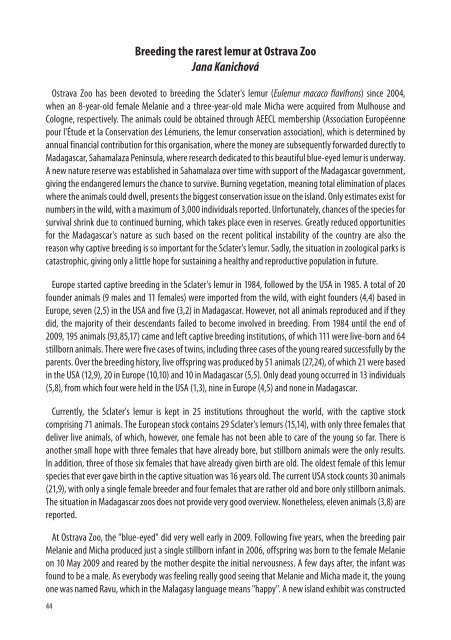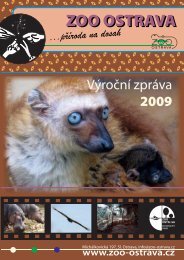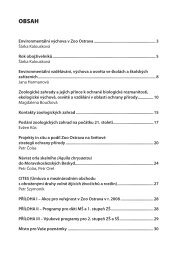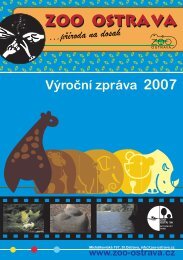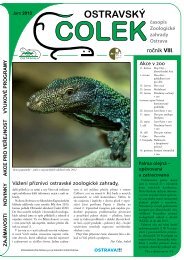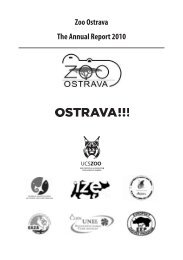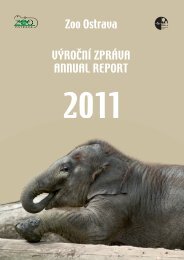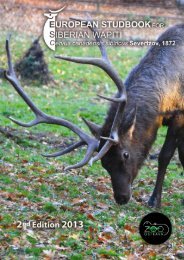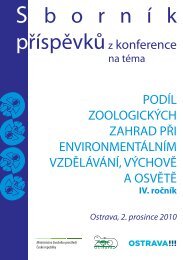You also want an ePaper? Increase the reach of your titles
YUMPU automatically turns print PDFs into web optimized ePapers that Google loves.
44<br />
Breeding the rarest lemur at <strong>Ostrava</strong> <strong>Zoo</strong><br />
Jana Kanichová<br />
<strong>Ostrava</strong> <strong>Zoo</strong> has been devoted to breeding the Sclater's lemur (Eulemur macaco flavifrons) since 2004,<br />
when an 8-year-old female Melanie and a three-year-old male Micha were acquired from Mulhouse and<br />
Cologne, respectively. <strong>The</strong> animals could be obtained through AEECL membership (Association Européenne<br />
pour l'Étude et la Conservation des Lémuriens, the lemur conservation association), which is determined by<br />
annual financial contribution for this organisation, where the money are subsequently forwarded durectly to<br />
Madagascar, Sahamalaza Peninsula, where research dedicated to this beautiful blue-eyed lemur is underway.<br />
A new nature reserve was established in Sahamalaza over time with support of the Madagascar government,<br />
giving the endangered lemurs the chance to survive. Burning vegetation, meaning total elimination of places<br />
where the animals could dwell, presents the biggest conservation issue on the island. Only estimates exist for<br />
numbers in the wild, with a maximum of 3,000 individuals reported. Unfortunately, chances of the species for<br />
survival shrink due to continued burning, which takes place even in reserves. Greatly reduced opportunities<br />
for the Madagascar's nature as such based on the recent political instability of the country are also the<br />
reason why captive breeding is so important for the Sclater's lemur. Sadly, the situation in zoological parks is<br />
catastrophic, giving only a little hope for sustaining a healthy and reproductive population in future.<br />
Europe started captive breeding in the Sclater's lemur in 1984, followed by the USA in 1985. A total of 20<br />
founder animals (9 males and 11 females) were imported from the wild, with eight founders (4,4) based in<br />
Europe, seven (2,5) in the USA and five (3,2) in Madagascar. However, not all animals reproduced and if they<br />
did, the majority of their descendants failed to become involved in breeding. From 1984 until the end of<br />
<strong>2009</strong>, 195 animals (93,85,17) came and left captive breeding institutions, of which 111 were live-born and 64<br />
stillborn animals. <strong>The</strong>re were five cases of twins, including three cases of the young reared successfully by the<br />
parents. Over the breeding history, live offspring was produced by 51 animals (27,24), of which 21 were based<br />
in the USA (12,9), 20 in Europe (10,10) and 10 in Madagascar (5,5). Only dead young occurred in 13 individuals<br />
(5,8), from which four were held in the USA (1,3), nine in Europe (4,5) and none in Madagascar.<br />
Currently, the Sclater's lemur is kept in 25 institutions throughout the world, with the captive stock<br />
comprising 71 animals. <strong>The</strong> European stock contains 29 Sclater's lemurs (15,14), with only three females that<br />
deliver live animals, of which, however, one female has not been able to care of the young so far. <strong>The</strong>re is<br />
another small hope with three females that have already bore, but stillborn animals were the only results.<br />
In addition, three of those six females that have already given birth are old. <strong>The</strong> oldest female of this lemur<br />
species that ever gave birth in the captive situation was 16 years old. <strong>The</strong> current USA stock counts 30 animals<br />
(21,9), with only a single female breeder and four females that are rather old and bore only stillborn animals.<br />
<strong>The</strong> situation in Madagascar zoos does not provide very good overview. Nonetheless, eleven animals (3,8) are<br />
reported.<br />
At <strong>Ostrava</strong> <strong>Zoo</strong>, the "blue-eyed" did very well early in <strong>2009</strong>. Following five years, when the breeding pair<br />
Melanie and Micha produced just a single stillborn infant in 2006, offspring was born to the female Melanie<br />
on 10 May <strong>2009</strong> and reared by the mother despite the initial nervousness. A few days after, the infant was<br />
found to be a male. As everybody was feeling really good seeing that Melanie and Micha made it, the young<br />
one was named Ravu, which in the Malagasy language means "happy". A new island exhibit was constructed


